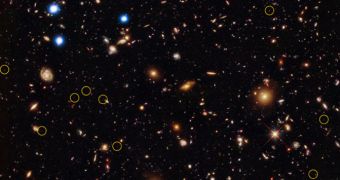According to a new scientific study, it would appear that the first black holes to develop in the early Universe – in the central regions of young galaxies – were even more difficult to spot than their more modern counterparts. They were obscured by clouds of cosmic dust and hydrogen gas.
For many years, astronomers have been analyzing the earliest galaxies in the universe to no avail, trying to find out where their black holes were. The studies were conducted to little success, but the new investigation managed to break through where others failed.
In the research, astronomers figured out that the first black holes were in fact located at the core of galaxies – as they are today – and also that they were severely obscured and smothered by vast amounts of cosmic dust and hydrogen gas.
Another important conclusion of the new work was that the evolution of the dark behemoths appears to have been closely intertwined with the evolution of their host galaxies. This had been hypothesized before, but never actually verified.
For the new study, University of Hawaii expert Ezequiel Treister used the NASA Hubble Space Telescope to identify the oldest galaxies, the most likely ones to contain supermassive black holes.
Then the team used the Chandra X-Ray Observatory to look for X-rays, radiation that usually forms as matter gets sucked into a black hole. This is one of the safest indirect ways of studying the objects.
“It's actually natural to expect all of these (early) galaxies to have growing supermassive black holes. And yet people hadn't found them before,” Treister explains. Studying the distant galaxies was however very difficult, since the Universe is more than 13.75 billion years old.
The study revealed that the black hole indeed existed, and that they belonged to the supermassive class as well. Their radiation could not be observed before due to the gas and dust surrounding them. “Only very high energy X-rays could go through,” the team leader says.
Experts also found clear correlations between the mass of the supermassive black hole and the mass of the dark matter halo surrounding the galaxy. The former was also related to the overall luminosity of the entire galaxy.
Thus far, theoretical studies suggested that this is possible only with time, as the galaxies and their black holes grow together. “The black hole grows in the center. But star formation is spread across the galaxy,” Treister says, quoted by Space.
“Why this connection happens and how it happens so quickly, we don't know,” he concludes, saying that more work is needed to tease out the intricate processes underlying the correlation.

 14 DAY TRIAL //
14 DAY TRIAL //